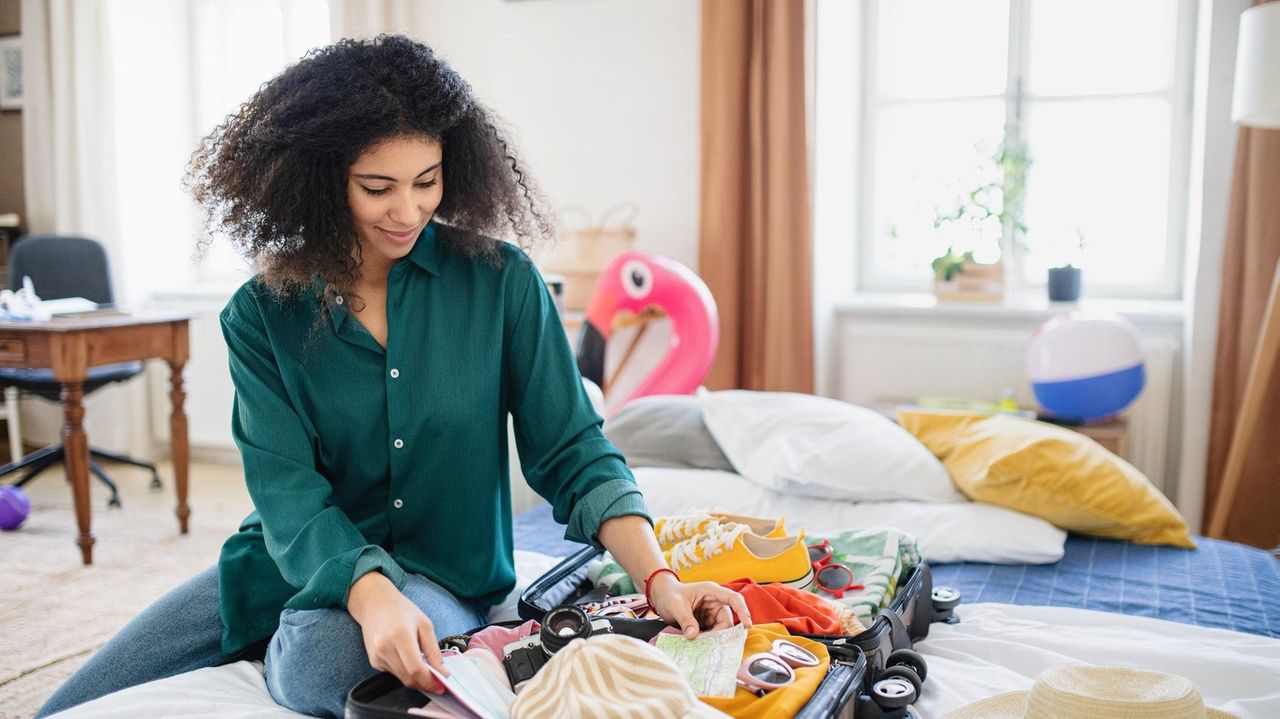Tips and tricks for packing a carry-on from crew members and frequent flyers
6 min read
United Airlines pilot Carole Hopson spent years honing her craft while taking countless trips around the globe. Eventually, she realized she’d mastered it. Not flying the 747 (she does that, too), but packing.
Before a recent flight to the Caribbean, Hopson dropped her bag on a luggage scale. “My suitcase was 13 pounds,” she said.
Years of discipline and sacrifice had brought her to this point: no throwing in another outfit at the last minute, no bulky hardcover beach reads.
“I’m so proud of myself. I didn’t start out that way,” Hopson said. “I’ve evolved to smaller — I find that the less I carry, the better.”
Over nearly a decade of travel writing, I’ve learned the same. Less stuff means less time wasted checking a suitcase at the airport and picking it up at baggage claim (or tracking down lost luggage). There’s also less money to spend on checked bag fees and less weight to heave into the overhead compartment.
We don’t have to match Hopson’s 13-pound achievement. But we can learn from her and other experts to become happier, more nimble travelers.
Be ruthless about nonessentials
The easiest way to go overboard is to start packing without a plan. How long is the trip? What’s the climate? Are you going to Michelin 3-star restaurants or sticking to street food? How many pairs of underwear is reasonable?
The world’s most frequent flyer is Tom Stuker, a New Jersey car dealership consultant who has clocked more than 23 million miles. He has a simple method: Instead of packing for the millions of “what if” scenarios, pack only what you absolutely need plus one backup, and make sure it’s easy to clean.
As you calculate those needs, be straight with yourself, says Yolanda Edwards, founder of the luxury travel magazine Yolo Journal. If you don’t actually like working out on vacation, skip the exercise clothes. While you’re doing that soul-searching, reflect on your past trips; what were items you definitely needed, and what could you have left behind?
“You’re going to be the one who, when you get home, you’re like, ‘I didn’t wear eight of those things, but I swore I needed them,’” Edwards said. “Try and remember all of those packing mistakes and try not to repeat them.”
Factor in a laundry day
Hopson usually travels with two T-shirts. This minimalist approach works because she stays in hotels with laundry facilities.
If your hotel doesn’t have that amenity, you can still do a decent wash in a sink, or venture to laundromats. I’ve loved my many side quests finding detergent and open laundromats everywhere from Tokyo to Berlin. Sure, it’ll suck up a few hours of your trip, but it’s a great opportunity for people-watching, post-card-writing or appreciating ordinary facets of local life.
Choose versatility over volume
Packing less doesn’t have to mean wearing the same outfit every day (although we do recommend locking in a travel uniform). Think back to the era of the fashion magazine Lucky (RIP), when we used to be constantly reminded of ways to mix and match your wardrobe to create more looks with less.
“I know a lot of people don’t like to repeat outfits, but … you don’t have to wear it the same exact way,” flight attendant Ashlee Loree said. “Versatility is everything when it comes to fashion and traveling, and making sure it’s comfortable, too.”
Jumpsuits, dresses and scarves are particularly flexible contenders, Loree says, as well as matching sets in different colors.
Edwards is a mega-fan of the Faye Flare Cropped Pant from Ann Mashburn. They can be dressed up with a blazer but are comfortable enough to wear on long flights.
Stuker said that “Lululemon pants are very comfortable and versatile for business and pleasure.”
Find your folding style
To roll or fold? That is the question, particularly as some travelers swear that rolling your clothing saves more space and causes fewer wrinkles than “flat packing.” That’s not always accurate, though. T-shirts and underwear do great with a tight roll; formal wear and chunky sweaters? Not so much.
Edwards prefers a hybrid. “I like to roll all the things that can handle rolling, and then I fold my nicer things I don’t want to have to iron and put that on top,” she said. That means items like her workout clothes get rolled while blazers or pants get folded flat.
Stuker uses leftover dry-cleaner hangers and plastic coverings to pack some clothing, and rolls the rest. Loree is also a roller, but her duffel doubles as a garment bag, so she can hang a few items, too.
Loree believes the roll method takes up less space but said travelers should make their own decision. “If it’s easier for you to fold and that takes up less space, do what works for you,” she said.
Use packing cubes and compression bags
Bags within bags are crucial for staying organized during a trip. Loree travels with packing cubes to separate her dirty laundry and shoes from her clean clothes, as well as a toiletry bag that hangs up in the bathroom.
I, too, love packing cubes, but my secret weapons are easy-to-use compression bags. I use them to divide categories of clothing — underwear and socks in one, workout clothes in another — then toss them into a larger compression bag that can shrink the load to about half its original size.
Keep essentials in your personal item
If you’re traveling with a rollaboard bag, you run the risk of it getting gate-checked. Prepare for that unfortunate fate by keeping critical items — medications, valuables — in your “personal item,” the backpack, purse or other bag small enough to stash under the seat.
It doesn’t hurt to keep other essentials close: a change of clothes, snacks, a portable power pack and a reusable water bottle.
Wear your bulkiest shoes and coats
Like all bulky items, shoes are a light packer’s biggest obstacle.
Loree uses a duffel bag with a shoe pouch to store strappy black sandals and a pair of lightweight tennis shoes (you might have a harder time stuffing multiple pairs if they are super-padded sneakers or boots). If she’s not using the duffel, she finds it most efficient to start packing her carry-on with shoes at the bottom and the rest of her items on top.
Edwards recommends saving your carry-on space by wearing bigger items — like big coats or clunky boots — on your travel day.
“Whatever’s my heaviest shoe will be what I wear on the airplane,” she said.
Pare down toiletries
Depending on your beauty routine, toiletry bags can get very full very fast. Be cutthroat about what you can take out or use travel-friendly containers that meet Transportation Security Administration carry-on requirements.
Loree buys travel-size containers for her favorite products. Edwards skips makeup and brings about eight toiletry items in a Muji case. Hopson has whittled down her regimen: “I’ve got my little makeup bag down to about the size of my hand,” she said.
Stuker’s reminder: Most basic toiletry items can easily be replaced on the road.
Bring a collapsible backup bag
If you’ve packed to the limits of your carry-on, you’ll be out of luck if you want to bring home a new suit from Hong Kong or a few bottles of wine from Tuscany. So carry a backup bag for such retail emergencies.
Loree always travels with a collapsible tote bag. For years, I’ve used Paravel’s nylon “Fold-Up Bag,” which zips up into the size of a Kindle and unfurls into a proper carry-on. It’s so small, there’s no downside of bringing it along.



